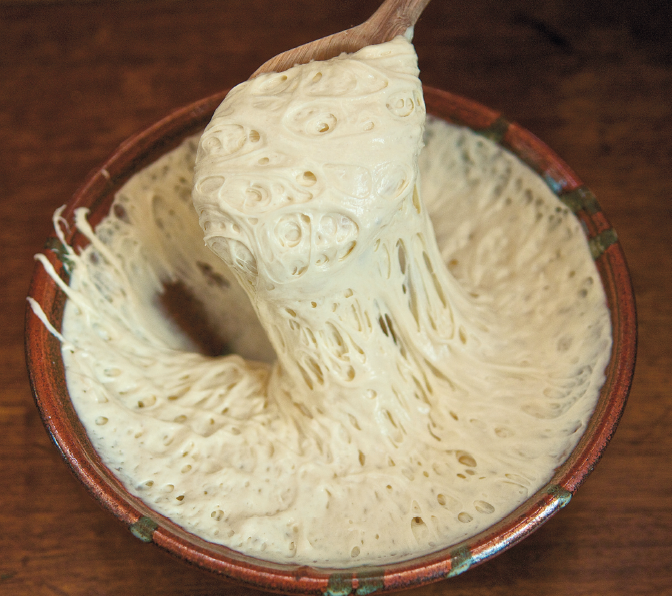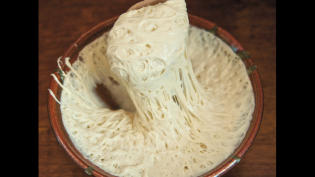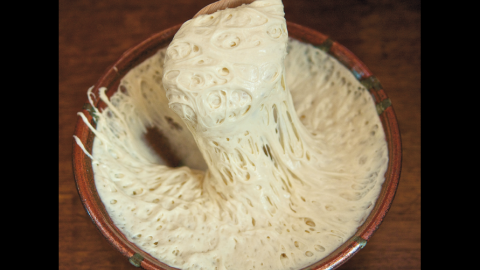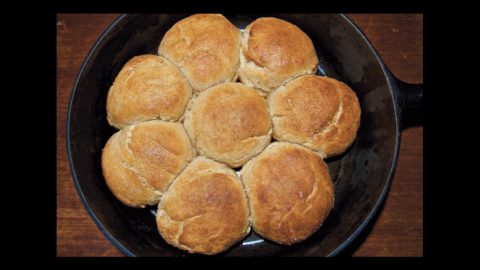Take a Walk on the Wild Side: Sourdough Bread
We're in the midst of a fermentation revival: pickles, kimchi, sauerkraut, salami, miso, homebrew and, of course, sourdough. It's fun to harvest invisible beneficial yeasts and lactobacilli and to put them to work transforming inert lumps of flour and water into complex flavors that are satisfying, wholesome and toothsome (pass the butter, please).
I've baked bread and taught bread baking for over 40 years but I'm an ingénue when it comes to the wild side. My baking has relied on commercial packaged yeast, only one strain: Saccharomyces cerevisiae. Very reliable, but not very exciting.
Now I'm capturing wild microbes to make bread rise– they're in the air and in the flour. Mix natural flour with water, leave it open to the air and it will come to life–potentially hundreds of strains of yeast and lactobacilli bacteria, depending on the flour, air and atmospheric conditions. After a few days of growing, the good bacteria and yeasts destroy anything that could be harmful. Beneficial microbes remain and work for us, predigesting and making nutrients more available. The yeasts and lactobacilli form a symbiotic colony creating a microbe community right there in the bread dough.
The result is a delicious depth of flavor, mildly sour with complex caramels and sugars, an airy interior and crisp brown crust. It is so satisfying to see that dull dough lump rise, become lively and elastic and finally spring into controlled expansiveness, beauteous, fulsome, almost bursting.
Catching Life, Care and Feeding
There are so many yeasts and bacteria floating in the air and hiding in the flour, it is impossible not to catch them. Long, long before man learned to use fire, he was fermenting. Fermentation happens on its own. For a starter all you need is flour and the activating ingredient–water.
Starter Recipe
1 clean glass 1-quart jar
1 cup water
1 1/2 cups unbleached flour
Mix water and flour in the glass jar. Leave open to the air for six–eight hours. Then cover lightly. Within hours the microscopic community starts working, breaking the starches into sugars, the proteins into gluten, and giving off the byproducts: carbon dioxide (same gas as in soda and beer), alcohol and lactic and acetic acids.
All you have to do now is feed it. Daily, for two weeks, add another cup of water and 1½ cups of flour, then stir. After three days the mixture will start bubbling–with life! You'll have to throw some away to keep it from foaming out of the jar. Keep the jar covered loosely with plastic wrap and a rubber band, so gases can escape. Careful: A tight lid will result in gas pressure buildup.
Also watch out: At this stage someone doing the dishes might try to clean up your starter. Label it with warnings: "Live Active Starter, DO NOT DESTROY!"
By feeding daily for two weeks you select for very active microbes that prefer a less acid environment. You now have a good, active starter that is ready to use. Your starter can now be refrigerated in between uses and fed as little as once a week, left out 24 hours to revive. I've heard stories of Alaskan starters keeping for 100 years in the chink of an old cabin. If you don't use the starter regularly, just dump most out and use the remainder to inoculate a fresh feed of flour and water.
I've Got My Starter, Now What?
Time to use that active, bubbly, tangy-delicious starter for sourdough breads and their relatives: biscuits, pancakes and even sourdough chocolate cake (recipe links in the sidebar).
Sourdough biscuits are a classic, but first a few notes on flour. Another culinary revival is sweeping through artisan bakeries nationwide: locally grown heritage wheat milled the old-fashioned way into whole-grain flours. One of the leaders in the movement, Hayden Flour Mills, is right here in Phoenix.
In 1874 Charles Hayden built a water-powered stone mill on the flowing Salt River. Hayden Mills was very successful, grinding wheat grown in the Valley for 124 years until it ground to a halt in 1998. In 2010 local wheat revolutionary Jeff Zimmerman registered the abandoned trademark and set out to find farmers, chefs, bakers and investors for the wild scheme of reviving locally grown heritage wheat varieties and grinding them into whole-grain flour.
Standing in the modern Hayden Flour Mills milling room (behind Pane Bianco, on North Central Avenue), I feel like I've found the Holy Grail. I'm surrounded by piles of 50-pound bags and shelves loaded with flour and grains, with more flour steadily streaming from the Austrian stone mill, which looks more like a fine piece of furniture than a functioning industrial machine. The owners (Jeff and Emma), the miller (Ben) and the baker (Marco) all radiate pride and passion in a process and product that is healthy, right for the planet and delicious.
Caught in the glow, I up my order–more, more, more flour for my happy brew of microscopic yeasties and beasties. This flour is hard to come by, available in only a few stores, farmers' markets and online (haydenflourmills.com).
The flours that come out of Hayden Flour Mills, and other stone mills around the country, have the following distinctive characteristics:
1. Flours are milled from historical varieties: Sonora White Wheat, Red Fife, Golden Durum and Farro (aka Emmer)–some of the same varieties that Charles Hayden milled.
2. Grains are grown without herbicides or other pesticides by small Arizona farms.
3. Grains are ground whole and kept whole (commercial "whole wheat" isn't whole; it's disassembled and then partially reassembled from the pieces).
4. Flours are freshly milled to order in small batches, unbleached, with no additives.
The Gluten Question
Lately there have been a lot of questions about wheat and its accompanying protein, gluten. As much as a third of the population may have "issues" with wheat, and this sensitivity is not well understood. There are a lot of theories, a whole lot of new "gluten free" foods that are highly refined and chemically based, and no scientific consensus on the problem. While the researchers are trying to figure it out, many chefs and bakers are theorizing that the problem lies in modern industrial processing techniques, and that the solution may be stone-ground whole heritage wheat, like that from Hayden Flour Mills.
Chef Molly Beverly is a food activist, teacher, caterer, food coach, chair of Slow Food Prescott and former chef of Crossroads Café. Thanks to Pangaea Artisan Bakery, Prescott for their assistance.
Beyond Bread, Other Recipes for Your Sourdough Starter
Chocolate cake (allrecipes.com/recipe/sourdough-chocolate-cake)
Chocolate chip cookies (commonsensehome.com/sourdough-cookies)
Pancakes (kingarthurfiour.com/recipes/classic-sourdough-waffles-or-pancakes-recipe)
Coffee cake (food.com/recipe/sourdough-coffee-cake-225416)
Sourdough Biscuits
Resources
Hayden Flour Mills, 4404 N. Central Ave., Phoenix (haydenflourmills.com) Order online or check website for retail locations.
The Art of Fermentation, by Sandor Ellix Katz (Chelsea Green, 2012)
Cooked: A Natural History of Transformation, by Michael Pollan (Penguin Press, 2013)
Sourdough Companion (sourdough.com)
Sourdough Surprises (sourdoughsurprises.blogspot.com)
Sourdough Home (sourdoughhome.com)








